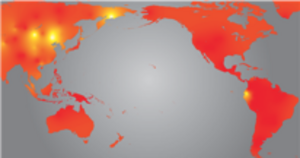The research group of Michael Nothnagel focuses on statistical genetics, including genetic epidemiology, population genetics and forensic genetics. This includes theoretical and methodological work as well as data analysis in collaborative projects, with a focus on human data. Michael Nothnagel and his co-workers take advantage of growing genome-wide datasets from genotyping and next-generation sequencing (NGS) as well as of specialized forensic genetic markers. Besides others, his group has made important contributions to the identification of genetic factors implicated in different human diseases, theoretical insights into disease etiology, the elucidation of continental and worldwide phylogeographic patterns of human genetic diversity and the selection of most informative markers in forensic applications. Michael Nothnagel and his co-workers are involved in a number of national and international projects on statistical genetics.

Selected publications
- Roewer L*, Nothnagel M*, Gusmão L, Gomes V, González M, et al. (2013). "Continent-wide decoupling of Y-chromosomal genetic variation from language and geography in native South Americans". PLoS Genet, 9(4):e1003460. (* equal contribution) doi: 10.1371/journal.pgen.1003460
- Purps J*, Siegert S*, Willuweit S, Nagy M, Alves C, et al. (2014). "A global analysis of Y-chromosomal haplotype diversity for 23 STR loci". Forensic Sci Int Genet, 12:12-23. (* equal contribution) doi: 10.1016/j.fsigen.2014.04.008
- Siegert S, Roewer L, Nothnagel M (2015). "Shannon's equivocation for forensic Y-STR marker selection". Forensic Sci Int Genet, 16C:216-225. doi: 10.1016/j.fsigen.2015.02.001
- Syrbe S, Hedrich UBS, Riesch E, Djémié T, Müller S, et al. (2015). "Hyperexcitability or electrical silencing: de novo loss- or gain-of-function mutations in KCNA2 cause epileptic encephalopathy". Nat Genet, 47(4):393-9. doi: 10.1038/ng.3239
- Siegert S, Wolf A, Cooper DN, Krawczak M*, Nothnagel M* (2015). "Mutations causing complex disease may under certain circumstances be protective in an epidemiological sense". PLoS One, 10(7):e0132150. (* equal contribution) doi: 10.1371/journal.pone.0132150
- Heilmann-Heimbach S, Herold C, Hochfeld L, Hillmer A, Nyholt D, et al. (2017). "Meta-analysis identifies novel risk loci and yields systematic insights into the biology of male-pattern baldness". Nature Comm, 8:14694. doi: 10.1038/ncomms14694
- Krause-Kyora B, Nutsua M*, Boehme L*, Pierini F*, Pedersen DD*, Kornell SC*, et al. (2018). "Ancient DNA study reveals HLA susceptibility locus for leprosy in medieval Europeans". Nat Commun, 9:1569. (* equal contribution) doi: 10.1038/s41467-018-03857-x
- Zhao L, He Z, Zhang D, Wang GT, Renton AE, Vardarajan BN, Nothnagel M, Goate AM, Mayeux R, Leal SM (2019). "A rare variant nonparametric linkage method for nuclear and extended pedigrees with application to late-onset Alzheimer Disease via WGS data". Am J Hum Genet, 105(4):822-835. doi: 10.1016/j.ajhg.2019.09.006
- Quach BC, Bray MJ, Gaddis NC, Liu M, Palviainen T, et al. (2020). "Expanding the genetic architecture of nicotine dependence and its shared genetics with multiple traits". Nat Commun, 11(1):5562. doi: 10.1038/s41467-020-19265-z
- Katsara MA, Branicki W, Pośpiech E, Hysi P, Walsh S, Kayser M, Nothnagel M, on behalf of the VISAGE Consortium (2021). "Testing the impact of trait prevalence priors in Bayesian-based genetic prediction modeling of human appearance". Forensic Sci Int Genet, 50:102412. doi: 10.1016/j.fsigen.2020.102412
